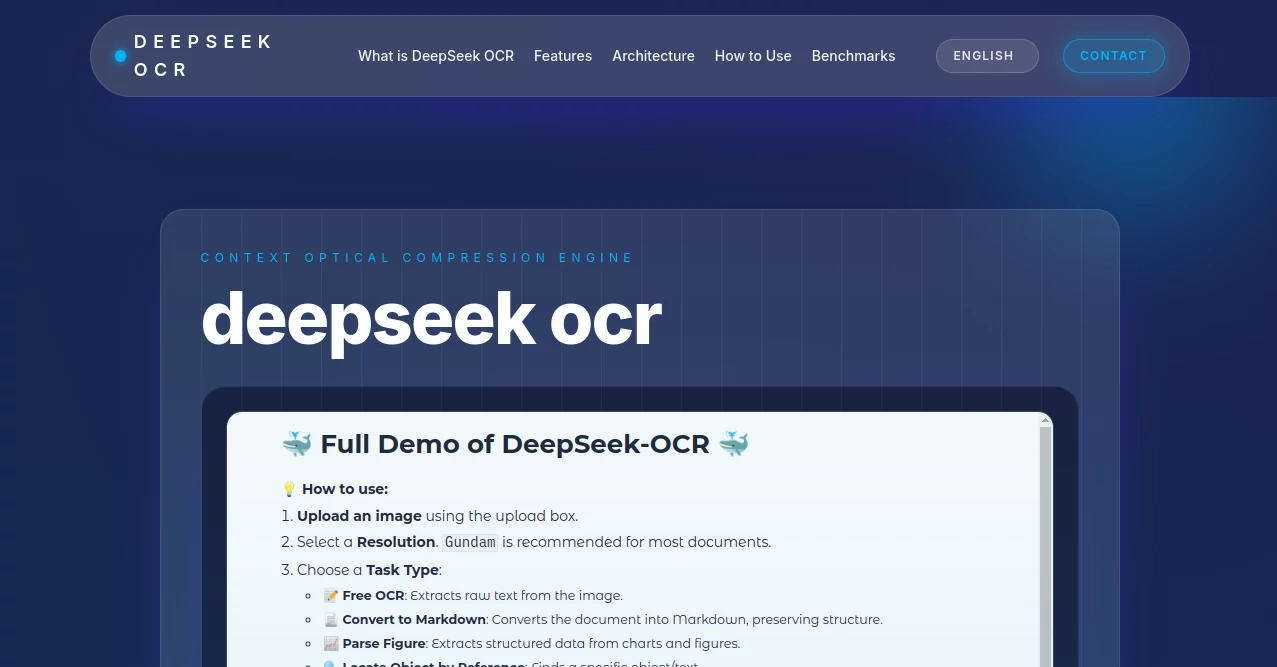DEEPSEEK OCR
Next-Gen Document Intelligence Unleashed

What is DEEPSEEK OCR?
DeepSeek OCR steps up as a powerhouse for pulling hidden gems from scanned pages and dense files, turning jumbled visuals into crisp, usable streams with barely a whisper of error. This setup shines for folks knee-deep in stacks of old reports or global forms, offering a way to sift through the mess and emerge with structured nuggets ready for deeper dives. Teams who've wrestled with clunky scans often light up sharing how it slashed their cleanup hours, breathing fresh life into dusty archives without the usual headaches.
Introduction
DeepSeek OCR sprang from a push to rethink how we tame the wilds of printed chaos, cooked up by minds tired of tools that choked on anything beyond plain lines. It hit the ground running a bit back, blending clever compression tricks with sharp decoding to handle the sprawl of real-world docs—think thick manuals or multilingual memos. Word spread quick among researchers and ops crews who needed more than spotty pulls, praising its knack for keeping the bones intact while slimming the bulk. What grabs hold is that balance of power and grace, letting you feed it hefty loads and get back treasures that feel hand-polished, all while keeping the gears humming on everyday hardware.
Key Features
User Interface
Getting in is straightforward—no flashy dashboards, just a clean entry via code pulls or simple calls that let you drop images and snag results without fanfare. Once set, it flows through setups where you tweak modes for speed or depth, with outputs landing in tidy formats like neat lists or marked-up sheets. Users nod to how it slots into daily routines, like a quiet helper that doesn't demand the spotlight but delivers every time you ping it.
Accuracy & Performance
It clocks in hits that rival the sharpest eyes, nailing down words and setups with rates that hover near flawless on tough tests, even as it squeezes files down to a fraction. Rips through batches at a clip that turns day-long jobs into afternoon sprints, holding steady on varied rigs without breaking a sweat. Folks test it on their trickiest piles and come away grinning at how it dodges the pitfalls that trip up lesser setups, keeping the flow tight and true.
Capabilities
This tool chews through everything from stacked tables to sketched notes, spitting out clean pulls in over a hundred tongues while holding onto the original shape—grids, charts, even formula scribbles. It trims fat from sprawling spreads, making room for bigger plays like feeding into analysis chains or building fresh datasets. Layer in extras for niche bits like chemical strings or geo marks, and it adapts without missing a beat, opening doors to workflows that blend visuals with deeper smarts.
Security & Privacy
Built for those wary of cloud shadows, it thrives on local turf where your stacks never stray beyond your walls, wrapped in open reins that let you lock it down tight. No sneaky shares or lingering traces—just process and purge, with nods to rules that keep sensitive hauls safe from prying paths. Crews in tight spots lean on this for that peace, knowing their edge stays buried deep in-house.
Use Cases
Researchers dust off forgotten tomes, yanking tales and tables for fresh spins in graphs or summaries that spark new hunches. Ops teams streamline invoice stacks, pulling keys into auto flows that cut the chase on payments. Global outfits harvest multilingual briefs, forging datasets that bridge borders without the translation tango. Even tech drawers tap it for blueprint notes, feeding extracted bits into design loops that speed the build.
Pros and Cons
Pros:
- Holds shape and sense through heavy shrinks, dodging data loss traps.
- Tackles tongues and tricks that stump the pack, from scripts to symbols.
- Runs lean on standard gear, flipping big loads without big bills.
- Open paths let you tweak and own the whole ride.
Cons:
- Demands a bit of setup savvy for the full local swing.
- Shorter on handwriting flair than some scribble specialists.
- Peak modes might nudge hardware needs for monster files.
Pricing Plans
Core access rolls free under open wraps, grabbing the full kit for your own spins without a tab. For those wanting hosted ease, it dips into token tallies around a few cents per batch, scaling with your haul—light dips for trials, heftier for steady streams. Bundle yearly for a trim, or stick local to sidestep the meter altogether, keeping costs as nimble as your needs.
How to Use DeepSeek OCR
Snag the setup from the shared spot, load your gear with the basics, and drop in your checkpoint to fire it up. Feed it a scan or sheet via quick calls, pick your squeeze level for the job, and pull the polished yield in your pick of wraps. Chain it to next steps like data sinks or review rounds, tweaking on the fly for that perfect fit, and watch old piles turn to gold in a handful of runs.
Comparison with Similar Tools
Against cloud heavyweights that bill by the byte, DeepSeek OCR keeps it local and light, matching their bite on dense docs but skipping the send-off risks. Where open basics falter on layouts, it layers in the smarts for grids and glosses, though those shine brighter on raw scripts. It carves a spot for the self-reliant, blending speed with staying power where others lean on the grid or graze the surface.
Conclusion
DeepSeek OCR flips the script on document drudgery, handing you a key to unlock troves without the toll. It bridges the gap from tangled scans to tidy insights, empowering dives that once drowned in detail. As stacks keep piling in our info flood, this gem stands ready, turning buried bytes into breakthroughs that propel the next big leap.
Frequently Asked Questions (FAQ)
What kinds of files does it chew through?
Scans, dense prints, even sketched tech bits—anything with words or shapes to mine.
How many languages can it juggle?
Over a hundred, from everyday scripts to niche notations, no sweat.
Is setup a beast for beginners?
A touch of code comfort helps, but guides smooth the path quick.
What if my docs are super sprawly?
Squeezes them down smart, keeping the meat while ditching the fat.
Can I run it without the web?
Fully local vibes, your data never leaves the room.
AI PDF , AI Document Extraction , AI Documents Assistant , AI Files Assistant .
These classifications represent its core capabilities and areas of application. For related tools, explore the linked categories above.
DEEPSEEK OCR details
This tool is no longer available; find alternatives on Alternative to DEEPSEEK OCR.
Pricing
- Free
Apps
- Web Tools
















